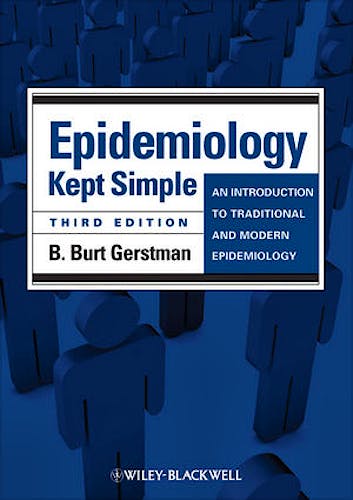

No hay productos en el carrito



Epidemiology Kept Simple. An Introduction to Traditional and Modern Epidemiology
Gerstman, B.
3ª Edición Abril 2013
Inglés
Tapa blanda
480 pags
1000 gr
null x null x null cm
ISBN 9781444336085
Editorial WILEY
LIBRO IMPRESO
-5%
69,59 €66,11 €IVA incluido
66,91 €63,57 €IVA no incluido
Recíbelo en un plazo de
2 - 3 semanas
LIBRO ELECTRÓNICO
-5%
58,66 €55,73 €IVA incluido
56,40 €53,59 €IVA no incluido
Acceso On Line
Inmediato
Description
This text introduces the history and the use of epidemiology as a discipline. It clearly explains the concepts and techniques associated with traditional epidemiology, the design of trials and the analysis of observational data and advanced biostatistical and epidemiologic techniques.
It includes practical exercises, case studies and real-world applications throughout and explains all new terminology with minimum use of technical language.
Table of contents
Preface to the Third Edition
Preface to the First Edition
Acknowledgments
1 Epidemiology Past and Present, 1
- 1.1 Epidemiology and its uses, 2
- 1.2 Evolving patterns of morbidity and mortality, 5
- 1.3 Selected historical figures and events, 8
- 1.4 Chapter summary, 30
- Review questions, 31
- References, 32
2 Causal Concepts, 36
- 2.1 Natural history of disease, 36
- 2.2 Variability in the expression of disease, 40
- 2.3 Causal models, 41
- 2.4 Causal inference, 48
- Exercises, 58
- Review questions, 61
- References, 63
3 Epidemiologic Measures, 66
- 3.1 Measures of disease frequency, 67
- 3.2 Measures of association, 74
- 3.3 Measures of potential impact, 79
- 3.4 Rate adjustment, 82
- Exercises, 90
- Review questions, 98
- References, 99
- Addendum: additional mathematical details, 101
4 Descriptive Epidemiology, 104
- 4.1 Introduction, 104
- 4.2 Epidemiologic variables, 108
- 4.3 Ecological correlations, 116
- Exercises, 121
- Review questions, 123
- References, 124
5 Introduction to Epidemiologic Study Design, 126
- 5.1 Etiologic research, 126
- 5.2 Ethical conduct of studies involving human subjects, 129
- 5.3 Selected study design elements, 130
- 5.4 Common types of epidemiologic studies, 137
- Exercises, 138
- Review questions, 140
- References, 141
6 Experimental Studies, 142
- 6.1 Introduction, 142
- 6.2 Historical perspective, 144
- 6.3 General concepts, 146
- 6.4 Data analysis, 152
- Exercises, 156
- Review questions, 157
- References, 157
7 Observational Cohort Studies, 159
- 7.1 Introduction, 159
- 7.2 Historical perspective, 161
- 7.3 Assembling and following a cohort, 163
- 7.4 Prospective, retrospective, and ambidirectional cohorts, 164
- 7.5 Addressing the potential for confounding, 165
- 7.6 Data analysis, 166
- 7.7 Historically important study: Wade Hampton Frost’s birth cohorts, 170
- Exercises, 174
- Review questions, 177
- References, 177
8 Case–Control Studies, 180
- 8.1 Introduction, 180
- 8.2 Identifying cases and controls, 182
- 8.3 Obtaining information on exposure, 185
- 8.4 Data analysis, 186
- 8.5 Statistical justifications of case–control odds ratio as relative risks, 193
- Exercises, 194
- Review questions, 198
- References, 199
9 Error in Epidemiologic Research, 201
- 9.1 Introduction, 201
- 9.2 Random error (imprecision), 203
- 9.3 Systematic error (bias), 209
- Exercises, 217
- Review questions, 219
- References, 220
10 Screening for Disease, 222
- 10.1 Introduction, 223
- 10.2 Reliability (agreement), 224
- 10.3 Validity, 228
- Summary, 238
- Exercises, 239
- Review questions, 243
- References, 243
- 10.4 Chapter addendum (case study), 244
- Further reading—screening for HIV, 248
- Further reading—general concepts of screening, 248
- Answers to case study: screening for antibodies to the human immunodeficiency virus, 249
11 The Infectious Disease Process, 255
- 11.1 The infectious disease process, 255
- 11.2 Herd immunity, 265
- Exercises, 267
- Review questions, 268
- References, 270
12 Outbreak Investigation, 271
- 12.1 Background, 272
- 12.2 CDC prescribed investigatory steps, 273
- Review questions, 282
- References, 283
- References—a drug–disease outbreak, 286
13 Confidence Intervals and p-Values, 302
- 13.1 Introduction, 303
- 13.2 Confidence intervals, 304
- 13.3 p-Values, 312
- 13.4 Minimum Bayes factors, 319
- References, 322
14 Mantel–Haenszel Methods, 323
- 14.1 Ways to prevent confounding, 323
- 14.2 Simpson’s paradox, 325
- 14.3 Mantel–Haenszel methods for risk ratios, 325
- 14.4 Mantel–Haenszel methods for other measures of association, 329
- Exercise, 335
- References, 335
15 Statistical Interaction: Effect Measure Modification, 337
- 15.1 Two types of interaction, 337
- 15.2 Chi-square test for statistical, 340
- 15.3 Strategy for stratified analysis, 342
- Exercises, 344
- References, 345
16 Case Definitions and Disease Classification, 347
- 16.1 Case definitions, 347
- 16.2 International classification of disease, 351
- 16.3 Artifactual fluctuations in reported rates, 353
- 16.4 Summary, 354
- References, 355
17 Survival Analysis, 356
- 17.1 Introduction, 356
- 17.2 Stratifying rates by follow-up time, 359
- 17.3 Actuarial method of survival analysis, 360
- 17.4 Kaplan–Meier method of survival analysis, 362
- 17.5 Comparing the survival experience of two groups, 364
- Exercises, 369
- References, 371
18 Current Life Tables, 373
- 18.1 Introduction, 373
- 18.2 Complete life table, 374
- 18.3 Abridged life table, 380
- Exercises, 383
- References, 384
19 Random Distribution of Cases in Time and Space, 385
- 19.1 Introduction, 385
- 19.2 The Poisson distribution, 386
- 19.3 Goodness of fit of the Poisson distribution, 390
- 19.4 Summary, 394
- Exercises, 395
- References, 396
Answers to Exercises and Review Questions, 398
Appendix 1: 95% Confidence Limits for Poisson Counts, 434
Appendix 2: Tail Areas in the Standard Normal (Z) Distribution: Double These
Areas for Two-Sided p-Values, 436
Appendix 3: Right-Tail Areas in Chi-Square Distributions, 439
Appendix 4: Case Study—Cigarette Smoking and Lung Cancer, 441
Appendix 5: Case Study—Tampons and Toxic Shock Syndrome, 448
Index, 455
© 2025 Axón Librería S.L.
2.149.0